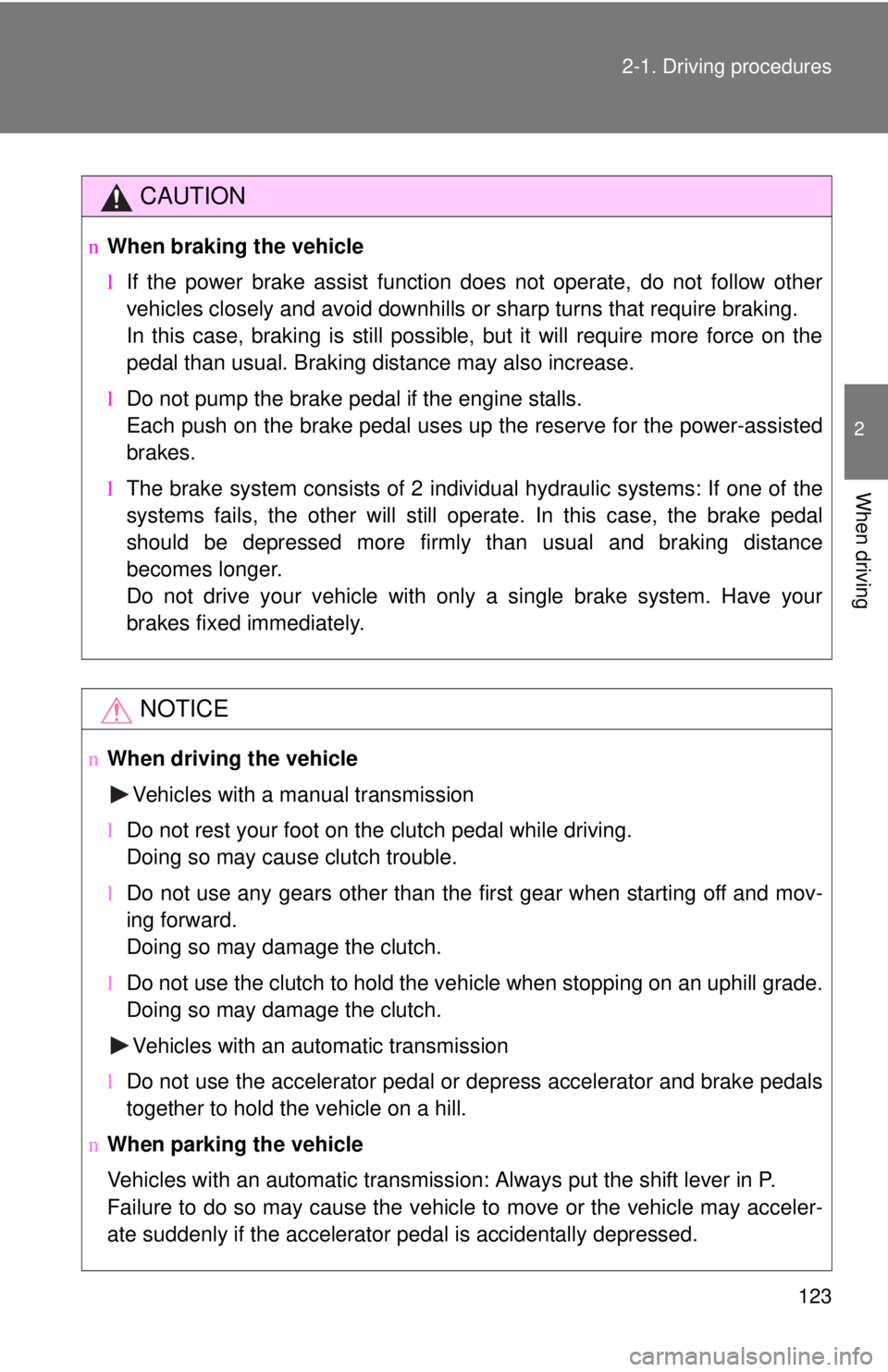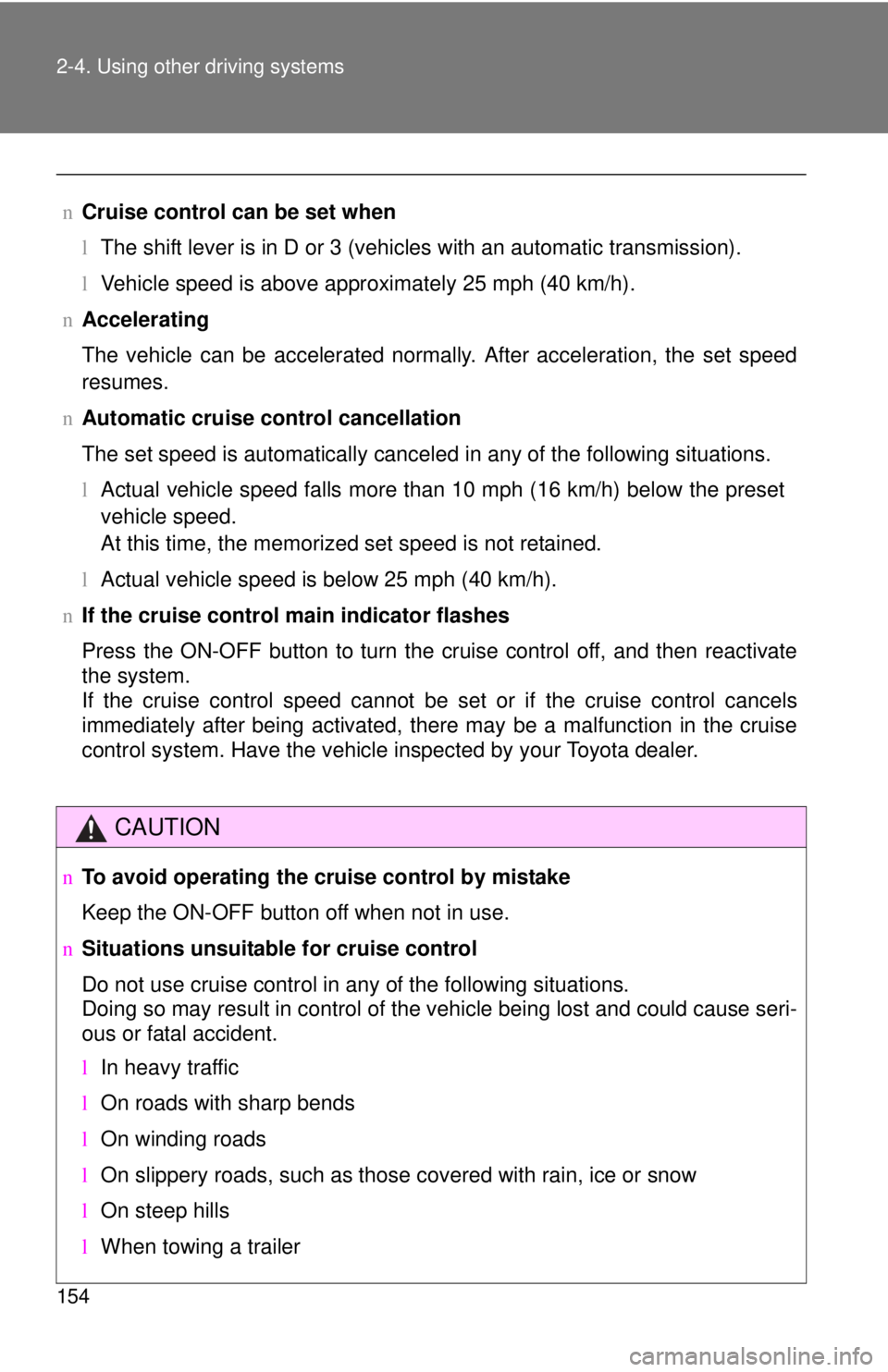Page 136 of 402

123
2-1. Driving procedures
2
When driving
CAUTION
n
When braking the vehicle
lIf the power brake assist function does not operate, do not follow other
vehicles closely and avoid downhills or sharp turns that require braking.
In this case, braking is still possible, but it will require more force on the
pedal than usual. Braking distance may also increase.
l Do not pump the brake pedal if the engine stalls.
Each push on the brake pedal uses up the reserve for the power-assisted
brakes.
l The brake system consists of 2 individual hydraulic systems: If one of the
systems fails, the other will still operate. In this case, the brake pedal
should be depressed more firmly than usual and braking distance
becomes longer.
Do not drive your vehicle with only a single brake system. Have your
brakes fixed immediately.
NOTICE
n When driving the vehicle
Vehicles with a manual transmission
l Do not rest your foot on the clutch pedal while driving.
Doing so may cause clutch trouble.
l Do not use any gears other than the first gear when starting off and mov-
ing forward.
Doing so may damage the clutch.
l Do not use the clutch to hold the vehicle when stopping on an uphill grade.
Doing so may damage the clutch.
Vehicles with an automatic transmission
l Do not use the accelerator pedal or depress accelerator and brake pedals
together to hold the vehicle on a hill.
n When parking the vehicle
Vehicles with an automatic transmission: Always put the shift lever in P.
Failure to do so may cause the vehicle to move or the vehicle may acceler-
ate suddenly if the accelerator pedal is accidentally depressed.
Page 138 of 402
125
2-1. Driving procedures
2
When driving
Engine (ignition) switch
nEngine switch
LOCK
The steering wheel is locked
and the key can be removed.
ACC
Some electrical components
such as the audio system can
be used.
ON
All electrical components can
be used.
START
For starting the engine.
nStarting the engine
Automatic transmission
Check that the parking brake is set.
Check that the shift lever is set in P.
Sit in the driver’s seat and firmly depress the brake pedal.
Turn the engine switch to the START position and start the
engine.
The engine will crank until it starts or for up to 20 seconds, which -
ever is less.
Continue depressing the brake pedal until the engine is com -
pletely started.
Page 139 of 402
126 2-1. Driving procedures
nTurning the key from ACC to LOCK
n S
teering lock release
nIf the engine does not st
art (vehicles with engine immobilizer system)
The engine immobilizer system may not have been deactivated. ( →P
. 74)
Manual transmission
Check that the parking brake is set.
Check that the shift lever is set in N. Firmly depress the brake pedal and clutch pedal.
Turn the engine switch to the START position and start the engine.
The engine will crank until it starts or for up to 20 seconds, which -
ever is less.
Continue depressing the brake pedal and clutch pedal until the
engine is completely st
arted.
Shift the shift lever to P (auto-
matic transmission) or N (man-
ual transmission).
(→P. 128, 130)
Push in the key and turn to the
LOCK position.
When starting the engine, the engine
switch may seem stuck in the LOCK posi-
tion. To free it, turn the key while turning
the steering wheel slightly in either direc-
tion.
Page 141 of 402
128
2-1. Driving procedures
Automatic Transmission (if equipped)
Select a shift position appropriate for the driving conditions.
nShifting the shift lever
While the engine switch is on, depress the brake pedal and
move the shift lever.
Page 143 of 402
130
2-1. Driving procedures
Manual Transmission (if equipped)
nMaximum allowable speeds
Observe the following maximum allowable speeds in each gear when maxi -
mum acceleration is necessary.
mph (km/h)
nShifting the shift lever
Fully depress the clutch pedal before operating the shift lever, and
then release it slowly.
Shift positionMaximum speed
1 31 (51)
2 59 (95)
3 86 (139)
Page 156 of 402
143
2-2. Instrument cluster
2
When driving
n
Indicators
The indicators inform the driver of the operating state of the
vehicle’s various systems.
Turn signal indicator
( →P. 131)
(vehicles with
tachometer)
Low fuel level indicator
Remaining fuel
•Flash
(Approximately 1.6 gal.
[6.3 L, 1.3 lmp.gal.] or
less)
• Fast flash
(Approximately 1.1 gal.
[4.2 L, 0.9 lmp.gal.] or
less)
Headlight high beam
indicator ( →P. 145)
(vehicles
without
tachometer)
(except
Canada)
Headlight indicator
( →P. 145)
(if equipped)
Cruise control main
indicator ( →P. 152)
(Canada)
Tail light indicator
( →P. 145)
(if equipped)
Cruise control set
indicator ( →P. 152)
(if equipped)
Front fog light indicator
( →P. 147)AIR BAG ON indicator
( →P. 93)
(Automatic transmission vehicles)
Shift position and shift range indica-
tors ( →P. 128)
AIR BAG OFF indicator
(→P. 93)
Low engine coolant
temperature indicator
Indicates the engine
coolant temperature is
cool.
Page 167 of 402

154 2-4. Using other driving systems
nCruise control can be set when
lThe shift lever is in D or 3 (vehicles with an automatic transmission).
l V
ehicle speed is above approximately 25 mph (40 km/h).
n Accelerating
The vehicle can be accelerated normally. After acceleration, the set speed
resumes.
n Automatic cruise control cancellation
The set speed is automatically canceled in any of the following situations.
l Actual
vehicle speed falls more than 10 mph (16 km/h) below the preset
vehicle speed.
At this time, the memorized set speed is not retained.
l Actual vehicle spee
d is below 25 mph (40 km/h).
n If the cruise control mai
n indicator flashes
Press the ON-OFF button to turn the cruise control off, and then reactivate
the system.
If the cruise control speed cannot be set or if the cruise control cancels
immediately after being activated, there may be a malfunction in the cruise
control system. Have the vehicle inspected by your Toyota dealer.
CAUTION
n To avoid operating the cruise control by mistake
Keep the ON-OFF button off when not in use.
n Situations unsuitable for cruise control
Do not use cruise control in any of the following situations.
Doing so may result in control of the vehicle being lost and could cause seri-
ous or fatal accident.
l In heavy traffic
l On roads with sharp bends
l On winding roads
l On slippery roads, such as those covered with rain, ice or snow
l On steep hills
l When towing a trailer
Page 175 of 402

162 2-5. Driving information
Regulations on the use of snow chains
lRegulations regarding the use of tire chains vary according to loca-
tion and type of road. Alwa
ys check local regulations before install -
ing chains.
l Use SAE Class “
S” type radial tire chains, with the exception of
radial cable chains or V-bar type chains.
• Install the chains on the front tires.
• Refer to the explanation that co
mes with the tire chains for
installation instructions.
l Re
tighten the chains after drivi ng 1/4 - 1/2 mile (0.5 - 1.0 km).
nSnow chain installation
Observe the following precautions when installing and removing chains.
l Inst
all and remove tire chains in a safe location.
lInst
all tire chains on the front tires only. Do not install tire chains on the
rear tires.
l Inst
all the tire chains on front tires as tightly as possible.
lInst
all tire chains following the instructions provided in the accompanying
instructions.
l If
wheel ornaments are used, they will be scratched by the chain band,
so remove the ornaments before putting on the chains. ( →P. 320)
nWhen driving the vehicle
Accelerate the vehicle slowly and drive at a reduced speed suit -
able to road conditions.
n When
parking the vehicle
Park the vehicle and move the shift lever to P (automatic trans -
mission) or to 1 or R (manual transmission) without setting the
p
arking brake. The parking brak e may freeze up, preventing it
from being released.